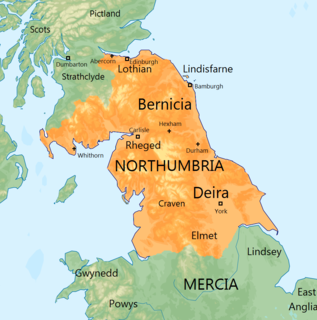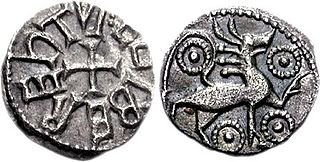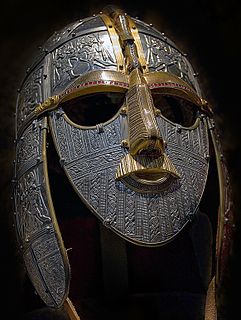The Council of Austerfield was an ecclesiastical synod held at Austerfield, in southern Northumbria in 702 or 703.

A synod is a council of a church, usually convened to decide an issue of doctrine, administration or application. The word synod comes from the Greek σύνοδος (sýnodos) meaning "assembly" or "meeting", and it is synonymous with the Latin word concilium meaning "council". Originally, synods were meetings of bishops, and the word is still used in that sense in Catholicism, Oriental Orthodoxy and Eastern Orthodoxy. In modern usage, the word often refers to the governing body of a particular church, whether its members are meeting or not. It is also sometimes used to refer to a church that is governed by a synod.

Austerfield is a village and civil parish in the Metropolitan Borough of Doncaster, on the border with Nottinghamshire. It lies to the north-east of Bawtry on the A614 road to Finningley, and is located at 53° 26' 30" North, 1° 0' West, at an elevation of around 23 feet above sea level. It is close to the River Idle, and has a population of 571, reducing to 536 at the 2011 Census.
The council was called by King Aldfrith of Northumbria to discuss whether Wilfrid should be returned to the see of York from which he had been expelled in 686. Wilfrid had appealed to the papacy around 700, and Pope Sergius I had sent the matter back to Britain to be decided locally. This resulted in Aldfrith convening the council in either 702 [1] or 703 according to different sources. [2] The date of the council has been calculated from two pieces of information: that it took place 22 years after the decision to expel Wilfrid from York, around 679–680, and that Wilfrid had held episcopal office for almost 40 years when Austerfield was convened. This would make the date of the council sometime before 704. [3]

Aldfrith was king of Northumbria from 685 until his death. He is described by early writers such as Bede, Alcuin and Stephen of Ripon as a man of great learning. Some of his works and some letters written to him survive. His reign was relatively peaceful, marred only by disputes with Bishop Wilfrid, a major figure in the early Northumbrian church.

Wilfrid was an English bishop and saint. Born a Northumbrian noble, he entered religious life as a teenager and studied at Lindisfarne, at Canterbury, in Gaul, and at Rome; he returned to Northumbria in about 660, and became the abbot of a newly founded monastery at Ripon. In 664 Wilfrid acted as spokesman for the Roman position at the Synod of Whitby, and became famous for his speech advocating that the Roman method for calculating the date of Easter should be adopted. His success prompted the king's son, Alhfrith, to appoint him Bishop of Northumbria. Wilfrid chose to be consecrated in Gaul because of the lack of what he considered to be validly consecrated bishops in England at that time. During Wilfrid's absence Alhfrith seems to have led an unsuccessful revolt against his father, Oswiu, leaving a question mark over Wilfrid's appointment as bishop. Before Wilfrid's return Oswiu had appointed Ceadda in his place, resulting in Wilfrid's retirement to Ripon for a few years following his arrival back in Northumbria.

Pope Sergius I was Bishop of Rome from December 15, 687, to his death in 701. He was elected at a time when two rivals, the Archdeacon Paschal and the Archpriest Theodore, were locked in dispute about which of them should become pope.
The council was called at a place described as in campo qui Eostrefeld dicitur and in campo qui dicitur Oustraefelda, which has led to the site of the council being identified with Austerfield near Bawtry in South Yorkshire (formerly in the West Riding of Yorkshire). Another possible location is Nosterfield near Ripon in the North Riding of Yorkshire. The main determining factor in favouring Austerfield over Nosterfield is that Nosterfield is not attested as a location before the 13th century. [4]
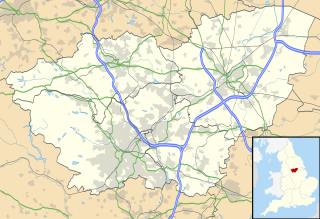
Bawtry is a small market town and civil parish sited where the western branch of the Roman Ermine Street crosses the River Idle in the Metropolitan Borough of Doncaster, South Yorkshire, England, close to its boundary with Nottinghamshire, and meets the old course of the Great North Road. Nearby towns include Gainsborough to the east, Retford to the south south-east, Worksop to the south-west and Doncaster to the north-west. Historically in the West Riding of Yorkshire, its population of 3,204 in the UK census of 2001 rose to 3,573 at the 2011 Census.

South Yorkshire is a metropolitan county in England. It is the southernmost county in the Yorkshire and the Humber region and had a population of 1.34 million in 2011. It has an area of 1,552 square kilometres (599 sq mi) and consists of four metropolitan boroughs, Barnsley, Doncaster, Rotherham and Sheffield. South Yorkshire was created on 1 April 1974 as a result of the Local Government Act 1972. Its largest settlement is Sheffield.

The West Riding of Yorkshire is one of the three historic subdivisions of Yorkshire, England. From 1889 to 1974 the administrative county, County of York, West Riding, was based closely on the historic boundaries. The lieutenancy at that time included the City of York and as such was named West Riding of the County of York and the County of the City of York.
The council was presided over by Berhtwald, the Archbishop of Canterbury. [5] It was attended by bishops from the entirety of the Anglo-Saxon church, both from Northumbria and from the southern part of Britain. [6] Besides the bishops, abbots from monasteries in Britain are recorded as attending at Austerfield, and Wilfrid's biographer records that Wilfrid was accompanied by a number of priests and deacons. [7] Laymen were also present, including King Aldfrith, [8] as well as some of Aldfrith's thegns. [3]
Berhtwald was the ninth Archbishop of Canterbury in England. Documentary evidence names Berhtwald as abbot at Reculver before his election as archbishop. Berhtwald begins the first continuous series of native-born Archbishops of Canterbury, although there had been previous Anglo-Saxon archbishops, they had not succeeded each other until Berhtwald's reign.

The Archbishop of Canterbury is the senior bishop and principal leader of the Church of England, the symbolic head of the worldwide Anglican Communion and the diocesan bishop of the Diocese of Canterbury. The current archbishop is Justin Welby, who was enthroned at Canterbury Cathedral on 21 March 2013. Welby is the 105th in a line which goes back more than 1400 years to Augustine of Canterbury, the "Apostle to the English", sent from Rome in the year 597. Welby succeeded Rowan Williams.
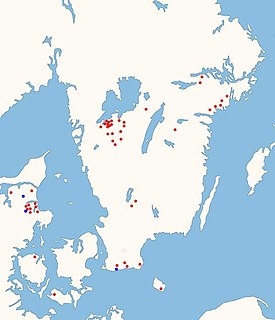
The term thegn, from Old English þegn, ðegn, "servant, attendant, retainer", "one who serves", is commonly used to describe either an aristocratic retainer of a king or nobleman in Anglo-Saxon England, or, as a class term, the majority of the aristocracy below the ranks of ealdormen and high-reeves. It is also the term for an early medieval Scandinavian class of retainers.
One account of the council survives, [1] that of Wilfrid's biographer, Stephen of Ripon in the Vita Sancti Wilfrithi . [2] Aldfrith and Berhtwald opposed Wilfrid's desire to return to York, but Wilfrid was supported by King Æthelred of Mercia, who had given Wilfrid shelter while he was in exile. [9] Most of the bishops attending as well as some abbots appear to have opposed Wilfrid. [10] According to Stephen, Wilfrid's opponents wanted to seize all Wilfrid's properties and offices, but Berhtwald offered a compromise that would have allowed Wilfrid to retain some monasteries but would have prevented him from performing the office of bishop. In response, Wilfrid gave a long speech that described all his career as a churchman. [2] The main difficulty lay in Wilfrid's refusal to obey Berhtwald, who had archiepiscopal authority over him. [10] The decision of the council was that Wilfrid should remain exiled from York and return to the monastery of Ripon and not leave and no longer be a bishop. Wilfrid disagreed with this decision and appealed to the papacy again. [1]

Stephen of Ripon was the author of the eighth-century hagiographic text Vita Sancti Wilfrithi. Other names once traditionally attributed to him are Eddius Stephanus or Æddi Stephanus, but these names are no longer preferred or accepted by historians today; modern usage tends to favor "Stephen."

The Vita Sancti Wilfrithi or Life of St Wilfrid is an early 8th-century hagiographic text recounting the life of the Northumbrian bishop, Wilfrid. Although a hagiography, it has few miracles, while its main concerns are with the politics of the Northumbrian church and the history of the monasteries of Ripon and Hexham. It is one of a collection of historical sources from the late 7th- and early 8th-centuries, along with the anonymous Vita Sancti Cuthberti, the works of Bede and Adomnán's Vita Sancti Columbae, that detail the Christianisation of Great Britain and make the period the best documented period in English history before the age of Alfred the Great.

Æthelred was King of Mercia from 675 until 704. He was the son of Penda of Mercia and came to the throne in 675, when his brother, Wulfhere of Mercia, died. Within a year of his accession he invaded Kent, where his armies destroyed the city of Rochester. In 679 he defeated his brother-in-law, Ecgfrith of Northumbria, at the Battle of the Trent: the battle was a major setback for the Northumbrians, and effectively ended their military involvement in English affairs south of the Humber. It also permanently returned the kingdom of Lindsey to Mercia's possession. However, Æthelred was unable to re-establish his predecessors' domination of southern Britain.
Wilfrid was eventually reconciled to the archbishop, bishops and laymen at the Council of Nidd in 705. [10]
